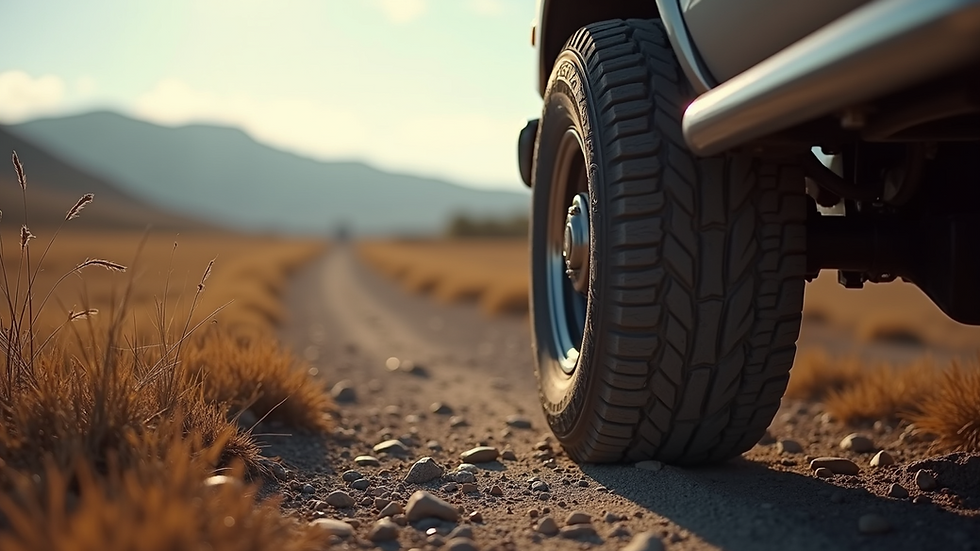Navigating the Secrets of RV Tire Durability and Performance
- Dave Kuiper
- Apr 19
- 4 min read
When adventure calls, nothing embodies freedom on the open road quite like an RV. This mobile home lets you explore captivating landscapes while enjoying the comforts of home. Yet, many RV owners overlook a crucial part of this journey: the tires. RV tires play a vital role in ensuring your safety, comfort, and the overall performance of your vehicle. Understanding how to choose, maintain, and optimize your RV tires can greatly enhance your travel experience. Whether you are an experienced RVer or planning your first trip, this guide will help you navigate the important details of RV tire care.
The Importance of RV Tires
RV tires support the entire weight of the vehicle and provide traction on a variety of terrains. They are engineered to handle the unique pressures associated with the size and weight of RVs. For instance, high-quality RV tires can improve your fuel efficiency by up to 10%. Investing in the right tires not only enhances your safety but also boosts ride comfort and vehicle stability.
Conversely, using inferior tires can lead to serious problems. According to the National Highway Traffic Safety Administration, tire issues contribute to thousands of accidents each year. Poor tire performance can lead to reduced handling, longer stopping distances, and even dangerous blowouts. Thus, prioritizing tire selection and upkeep is essential.
Choosing the Right RV Tires
Types of RV Tires
Choosing the right tires starts with knowing the types available. Here are two main options:
Bias Ply Tires: Known for durability, these tires feature layers of fabric that offer a cushioned ride. They’re ideal for lighter RVs and occasional trips but may not perform optimally for frequent long-distance travel.
Radial Ply Tires: Built with steel and nylon belts running radially, these tires deliver superior traction and improved fuel efficiency. They are recommended for larger RVs and are perfect for long-haul trips. Studies show that radial tires can provide up to a 15% increase in fuel economy compared to bias ply options.
Load Rating
The load rating indicates how much weight each tire can safely support. For a safe and efficient RV experience, your tires should match or exceed the weight of your fully loaded vehicle. For example, if your RV weighs 5,000 pounds when loaded, divide this by four (the number of tires) to ensure each tire has an adequate load rating of at least 1,250 pounds. Always refer to your RV’s owner manual for specific load requirements.
Tire Size
Choosing the right tire size matters. The correct dimensions improve handling, reduce wear, and enhance overall safety. Check the specifications on the RV's tire placard, typically found on the driver’s door jamb, to find the appropriate tire size for your vehicle.
Maintaining Your RV Tires
Regular Inspections
Performing routine tire inspections is vital for optimal performance. Examine tires for signs of wear, such as cracks or bulges, and check tread depth regularly. Statistics indicate that tires lose around 1 PSI for every 10-degree Fahrenheit drop in temperature. A simple visual inspection can prevent accidents during your travels.
Tire Pressure
Maintaining the proper tire pressure is essential for safety and performance. Under-inflated tires can wear out prematurely and increase fuel consumption by as much as 3%, while over-inflated tires can cause a harsh ride and increase the risk of blowouts. Utilize a reliable tire pressure monitoring system (TPMS) to oversee tire pressure while on the road.
Rotation and Alignment
Like other vehicles, RV tires should be rotated regularly to minimize uneven wear and extend their lifespan. Additionally, ensure proper wheel alignment to prevent handling issues. A misaligned RV can lead to a 20% decrease in tire life, resulting in costly replacements.
Malfunctions to Look Out For
Being proactive about potential malfunctions can save you from future troubles. Keep an eye out for:
Cracking and Bulging: Over time, tires can develop cracks and bulges, often due to UV exposure or improper inflation. These faults can lead to blowouts if not addressed.
Uneven Wear: Signs of uneven wear can hint at alignment issues, incorrect inflation, or suspension problems. Identifying these early can help you avoid costly repairs down the line.
Seasonal Considerations
Tire performance can change with the seasons:
Summer
In hot weather, air pressure in tires can increase, leading to blowouts if they are over-inflated. It's advisable to check tire pressure every two weeks during the summer months.
Winter
Cold temperatures can diminish tire pressure and traction. Consider investing in winter tires if you plan to travel in snowy or icy conditions. Regular pressure checks are crucial in colder months, as tires can lose up to 2 PSI for every 10-degree Fahrenheit drop in temperature.
Investing in Quality Tires
While purchasing high-quality tires often requires a larger initial investment, it can lead to significant savings over time. Focus on reputable brands with strong customer reviews, as these typically offer better warranties and performance. For example, investing in Michelin or Goodyear tires could enhance your RV's performance and longevity.
Local Tire Dealers
Working with local tire dealers who specialize in RVs can be incredibly beneficial. They often have valuable insights into which tires are best suited for your specific vehicle and travel habits, helping you make informed choices.
Final Thoughts
Understanding RV tires goes beyond just picking the right ones. The right choices enhance your safety and comfort while prolonging the life of your investment. By carefully selecting tires based on your RV's specifications and regularly maintaining them, you will ensure a smoother traveling experience. Whether heading out for a quick weekend trip or embarking on a long journey across the country, keeping your tires in top shape will make all the difference.
Navigating the secrets of RV tire durability and performance not only ensures your vehicle is roadworthy but also maximizes your adventure. So gear up, inspect your tires, and hit the road with confidence for your next great journey!







Comments